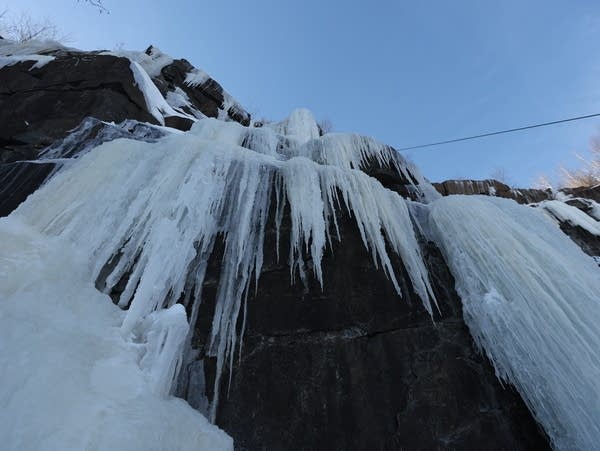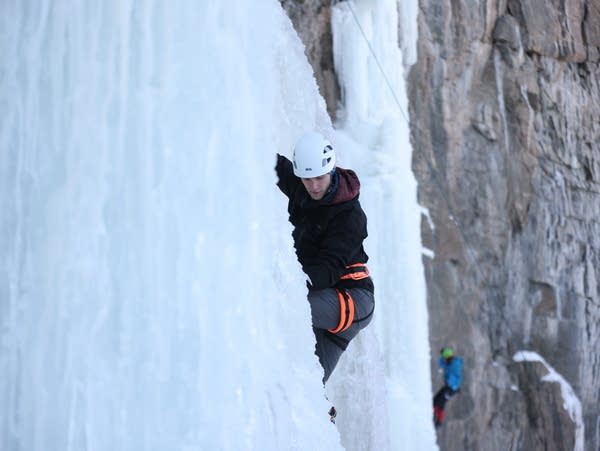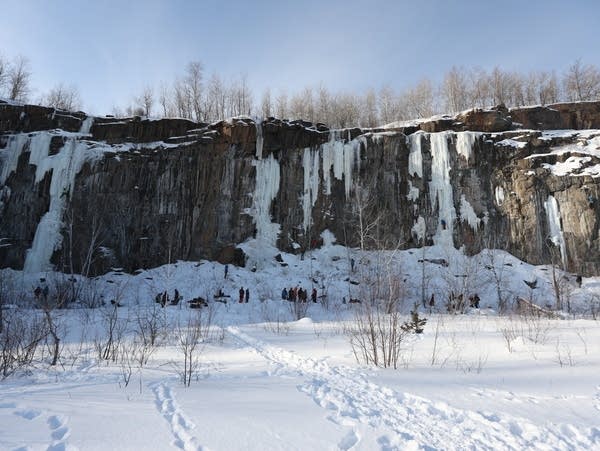These Minnesotans farm ice — and it’s drawing climbers from across the U.S.

Go Deeper.
Create an account or log in to save stories.
Like this?
Thanks for liking this story! We have added it to a list of your favorite stories.
Earlier this month, Brandy Arredondo strapped crampons on her boots, grabbed two elegantly curved ice axes, and warily approached a frozen cliff face.
“I’m super nervous,” she confessed.
She moved to Duluth from Tampa, Fla., just a year ago. Now her friend Juliet Homme had talked her into trying ice climbing for the first time at the Duluth Ice Fest, a day of clinics and demonstrations at the city's Quarry Park.
Arredondo swung one of her axes until it stuck in the glistening column of ice. Then she kicked in one of her crampons, then the other, and slowly worked her way up the vertical wall of ice. She climbed about ten feet or so, until her hands became too numb to continue.
Turn Up Your Support
MPR News helps you turn down the noise and build shared understanding. Turn up your support for this public resource and keep trusted journalism accessible to all.
“You did so good!" yelled Homme. Back on solid ground, Arredondo said she'd definitely try it again, once her hands warm up.
"It was very hard, but I enjoyed it,” she said, grinning. “It was fun, exhilarating."
Planning consistent ice
Climbers have been scaling the 100-foot-tall cliffs here since the early 1980s in what climbers affectionately call Casket Quarry, because of the remnants of concrete burial vaults that used to be made nearby.
But the natural ice was inconsistent. In dry years, hardly any formed.

So several years ago, local climbers hatched a plan to pipe water to the top of the cliffs and spray it over the sides to create consistent ice-climbing conditions.
After years of working with city engineers to design a system, countless volunteer construction hours, and lots of troubleshooting, the irrigation system came online just in time for this year’s climbing festival.
"And to be honest, we wouldn't be having an ice fest today if it wasn't for building the system,” said Nick Fleming, one of the founding members of the Duluth Climbers Coalition and now its chief ice farmer.
Quarry Park is now Minnesota's third city-owned park with volunteer-run ice farming systems for climbing. That's more than any other state in the country. The first was built in an old quarry in Sandstone. The biggest is in Winona.
Growing national reputation
Most ice climbing is still done on natural ice in the country’s mountainous west and northeast. But word of Minnesota's ice parks is getting out.
“All of a sudden, Minnesota is looking kind of like the ice climbing state, outside of the intermountain west,” said Eric Barnard, a board member for the Minnesota Climbers Association. He’s an ice climber and ice farmer in Winona.
“I know folks who are flying from Oregon at the end of February to come on an ice climbing trip here, which is crazy to me.”

‘It’s really absurd’
Ice farming in Minnesota dates back to the early 2000s, when a local climber in the small town of Sandstone pumped water from a pond over the edge of an old quarry cliff.
That covert experiment eventually led to a partnership between the city and the Minnesota Climbers Association in 2010, when the city installed a water source a few hundred feet from the cliff’s edge at Robinson Park.

“We made a lot of mistakes at Sandstone learning how to do it,” recalled former association president James Loveridge. A big challenge was how to prevent water lines from freezing. They consulted with ice farmers at the Ouray Ice Park in southwestern Colorado, the largest and best known ice climbing park in the country.
“There's two ways to keep water from freezing: pressure and flow,” Loveridge said. “So it's about balancing how much water is going through the system and how much pressure you have out each end.”
‘What could go wrong, right?’
Climbers in Winona then consulted with Loveridge and others when they began farming ice at the Winona Ice Park, which opened along the bluffs overlooking the Mississippi River in 2017.
Unlike the parks in Duluth and Sandstone, which have some natural ice, the park in Winona relies entirely on farmed ice. Barnard, one of about a half dozen volunteer ice farmers at the park, said there's been a lot of trial and error since.

"I always joke, running thousands of feet of pipe filled with water in a Minnesota winter, like what could go wrong, right?" said Barnard, who managed the adventure education program at Winona State University.
"And all you can do is laugh about it. When you're getting sprayed in the face, like hundreds of gallons of water a minute, and you're soaked and covered in ice. It's really absurd.”
“But then once you make it, it is almost an art form.”
That art has grown considerably over the years. The Winona Ice Park now boasts about 100 climbing routes. On weekends it’s not uncommon to see groups of climbers from Kansas to Texas to North Carolina.
“That's really been a boon for Winona,” said city manager Chad Ubl.
But it’s a lot of work. He recently stopped by the park to make sure everything was working fine, and ended up spending five hours there dealing with problems. He said his crew of ice farmers in Winona have talked about having a summit to share information, and more importantly, encouragement.
“If nothing else, just to give everybody a hug,” Ubl said. “It is really crazy what a little niche that we're dealing with here. There's probably only a handful of ice farmers in the world.”
How’s the ice made at Quarry Park?
Minnesota’s newest ice farming system is also among its most high-tech.
Duluth city water is piped into an underground pump house in a concrete bunker that was part of the quarry that operated here a century ago and inspired the park’s name.

Nick Fleming, head ice farmer for the Duluth Climbers Coalition, points to a monitor displaying how much water is coming in and going out and at what temperatures, flow rates, and water pressure of the different irrigation lines.
He can even remotely control valves from his cell phone, so he doesn’t have to drive across town to fix something.
Because there’s no water at the top of the cliff, volunteers buried 1,200 feet of pipe underground, up 160 feet in elevation, to the top of the quarry.
From there the water line feeds 10 sprinkler heads spaced along the top of the cliff to create thick pillars and columns of ice for climbing routes.

It took years of working with city engineers to design a system and lots of volunteer hours to get it built. But in the end, “we were able to build a one-of-a-kind system,” said Fleming.
Like the volunteer ice farmers in Winona, Fleming dedicates a lot of time to his craft. He works 24-hour shifts as a firefighter for the city of Duluth. When he's off, he's usually here, farming ice or tinkering with the system.
"I kind of took it on as a personal goal to see it through. And we took what was originally just a partying and dumping area, hidden in the woods, and we turned it into a park that is used by the neighborhood.”
“We've really transformed this vacant piece of land into a recreational spot for everyone to use.”
‘World-class’ climbing
Both Fleming and Barnard say they’ve talked to many individual climbers and groups interested in farming ice to create their own climbing parks, in Wisconsin, the Upper Peninsula of Michigan, and farther south in Indiana and Ohio.

Minnesota climbing groups have addressed concerns about water usage and cost, and what happens to the water when it melts in the spring.
In Winona, last year the park used 934,000 gallons of water, at a cost to the city of about $3,500. That’s about what 10 households use in a year.
Winona outdoor recreation coordinator Alicia Lano said people were also concerned that the water would come gushing off the bluff in the spring when it melted. But through a process called sublimation, she explained, the water mostly evaporates, and the ice slowly shrinks.
“I think at first a lot of the locals were really hesitant about it, because they're like, ‘it's not natural,’” said Lano.
“But now that it's been here for several years, the community members are definitely now more open to it and love seeing it and hiking up to it and seeing the beauty of it.”

In Duluth, Fleming estimates the water used by the ice farming will cost between $1,000 and $2,000, with electricity for the pumps costing around another $1,000. All of that is paid for by the climbing organization, he said, in part with funds raised at the Ice Fest.
And while Minnesota’s ice climbing parks may never match the grandeur of ice climbing out west, Minnesota Climbers Association’s James Loveridge, who’s climbed around the world, said the climbing itself is “world-class.”
“If [Quarry Park] was an hour outside of Denver, there would be hundreds of people there every weekend. I guarantee that,” he said. “And here we have this right in Duluth. And it’s awesome.”


